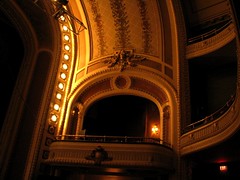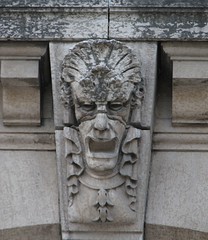Address: 364 Smith Street (Map)
Opened: December 17, 1906 (official opening Feb 18 1907)
Architect: Howard C. Stone
Contractor: Canadian White Co. (Montreal)
Background:

Corliss Powers Walker and his wife Harriet Anderson Walker owned a small chain of theatres in the U.S. Midwest. They worked as a team with him responsible for the business dealings while she handled the bookings and promotions.
They moved to Winnipeg in 1897 and leased the Bijou Theatre, renaming it the Winnipeg Theatre. Their goal was to one day have a custom-built theatre here that would be the centrepiece of their chain.
Finally, in 1905, they hired Montreal architect Howard Colton Stone to draw up plans for a theatre, inspired by Chicago's Auditorium Theatre, along with a hotel complex that would be added at a later date. This explains why the building's facade is largely of plain brick with the exception of a small stone facade around the entrance. (In the Smith Street elevation above I have placed the existing facade beneath where it was to fit into the master plan.)
I cannot find references as to why the hotel was never constructed. I imagine, though, that the difficulties encountered by the nearby independent Olympia / Marlborough Hotel would have kept the Walkers out of the railway-dominated high-end hotel business.
The Walkers went to great lengths to be able to claim that the building was "completely fireproof", a good selling feature in an era of disastrous theatre fires around North America. (In fact, the Walkers' former Winnipeg Theatre burned in 1926 killing four firemen and injuring 11 others.)
The Theatre features a steel frame construction with concrete exteriors walls and floors throughout, even for the balconies and beneath the stage. The interior walls are clad in terra cotta.
There were more entrances than required by the era's fire code and it was said that the hall could be vacated in less than three minutes. A forced air system ensured not only comfort for patrons but allowed for the quick removal of smoke should fire ever strike.
Construction was delayed for several weeks due to a series of city-wide builders' strikes in 1906. Their first booking, however, had already been made: the Australian youth musical troupe Pollard's Lilliputian Opera Company. They had no choice but to open the theatre on December 17, 1906 and Pollard's headlined for three weeks.
Construction continued around show schedules for several weeks. The formal opening took place on February 18, 1907 with a production of Madame Butterfly.
The Walkers worked hard to live up to their billing as Canada's Finest Theatre by booking A-list acts from around the world.
The Walker saw the likes of Clara Butt, Maude Adams, Adelina Patti, Viola Allen, Margaret Anglin, Edythe Chapman, May Robson, Florence Easton, George Arliss, Johnstone Forbes-Robertson, Robert Mantell, Dustin Farnum, Conway Tearle and Lillian Russell. (Note, not Charlie Chaplin!)
Sadly, the Walker Theatre was home to the final performance of British acting couple Laurence Irving and Mabel Hackney.
After a series of successful dramas staged in May 1914 they left ahead of their crew to take the Empress of Ireland back to England. The ship sank en route, killing more than 1,000 people, including Irving and Hackney.
It also hosted a number of significant local political events.
On January 28, 1914, it was the scene of the Political Equity League's Mock Parliament co-organized by led by Nellie McClung, a good friend of Harriet Walker's. On December 22, 1918 it hosted one of the largest pre-general strike meetings chaired by John Queen that passed several "radical" resolutions.
For the Walkers, it was a crushing loss. They would never see the theatre open again as C.P. Walker died in 1942 at the age of 89 and Harriet died the following year.
The city leased the theatre short-term to local promoters and it hosted numerous political speeches, concerts, and school recitals. The city lost money on these leases and in 1944 decided that the time was right to put the venue up for sale.
Just two offers came in, both for around $35,000, which caused splits on city council. Some wanted to hold out for more money, some wanted assurances that the theatre would not be bulldozed, and others felt that the city just needed to be rid of the "white elephant" regardless of price or outcome.
The purchase deadline was extended for another week to see if better offers would come, but none did.
One of the offers was from Henry A. Morton, manager of the nearby Odeon Garrick, a theatre of the same vintage that had been retrofitted into a cinema. He had similar plans for the Walker.
To sweeten his bid, Morton added a last-minute guarantee that the Walker would remain a theatre for a period of ten years, even if he ended up selling it or leasing it to another party. Council voted 10 to 7 in favour of his bid.
The Walker underwent a number of renovations to convert it into a cinema. The seats were replaced, a dropped ceiling was installed, the lobby was modernized and a screen and sound system added. It reopened on November 3, 1945 as the Odeon Cinema with the James Cagney film Blood on the Sun.
The Walker continued on until March 29, 1990 when Cineplex Odeon closed it and put it up for sale.
Two groups vied for the building in 1990.
One was the Manitoba Choral Society and the other was a non-profit group headed by Nite-Out Entertainment's Sam Katz and Bruce Rathbone, (now known as the Walker Theatre Performing Arts Group Inc.) The latter won out and purchased the building on October 1, 1990 for $700,000, which included a $250,000 grant from the Core Area Initiative.
The group began a multi-year restoration project to undo what Odeon did decades earlier. Fortunately, the hidden treasures were left mostly intact.
The stage behind the giant screen was an empty void, the stunning terra cotta and plaster was in place though damaged by the installation of the dropped ceiling and other modernities, and even the third balcony, nicknamed the "Gods", was found under the false ceiling.
The Walker reopened on March 1, 1991, in the midst of renovations, with a concert by Blue Rodeo.
In August 2002 The Walker was renamed for Winnipegger and Guess Who front man Burton Cummings in exchange for playing some benefit concerts to help retire the theatre's then $1.8m debt.
In 2007, the Walker Theatre was named a National Historic Site.
UPDATE 2014:
The theatre struggled as a stand-alone, live venue. In April 2014 True North Entertainment, owner of the Winnipeg Jets and MTS Centre arena, announced that they had reached a long-term lease agreement with the Walker Theatre Performing Arts Group Inc..They will now be responsible for the bookings and its management.
Related:
Burton Cummings Theatre website
Walker Theatre Vignette Heritage Winnipeg
Walker Theatre Winnipeg Building Index
364 Smith Street Historic Buildings Committee Report
My Flickr album of the Walker Theatre
Finest playhouse in the Dominion Cherney Pt 2
Agenda Paper: The Walker Theatre Parks Canada
History and Chronology Burton Cummings Theatre
Also see:
On Stage: Theatre and Theatres in Early Winnipeg MHS
There is also a book called 'Curtain Time' by Ruth Harvey, daughter of the Walkers, published in 1949. Excerpts appeared in the Winnipeg Tribune that year.











No comments:
Post a Comment